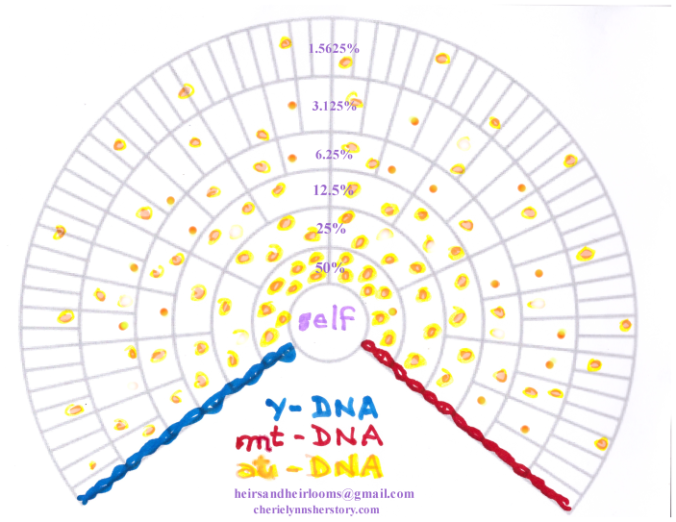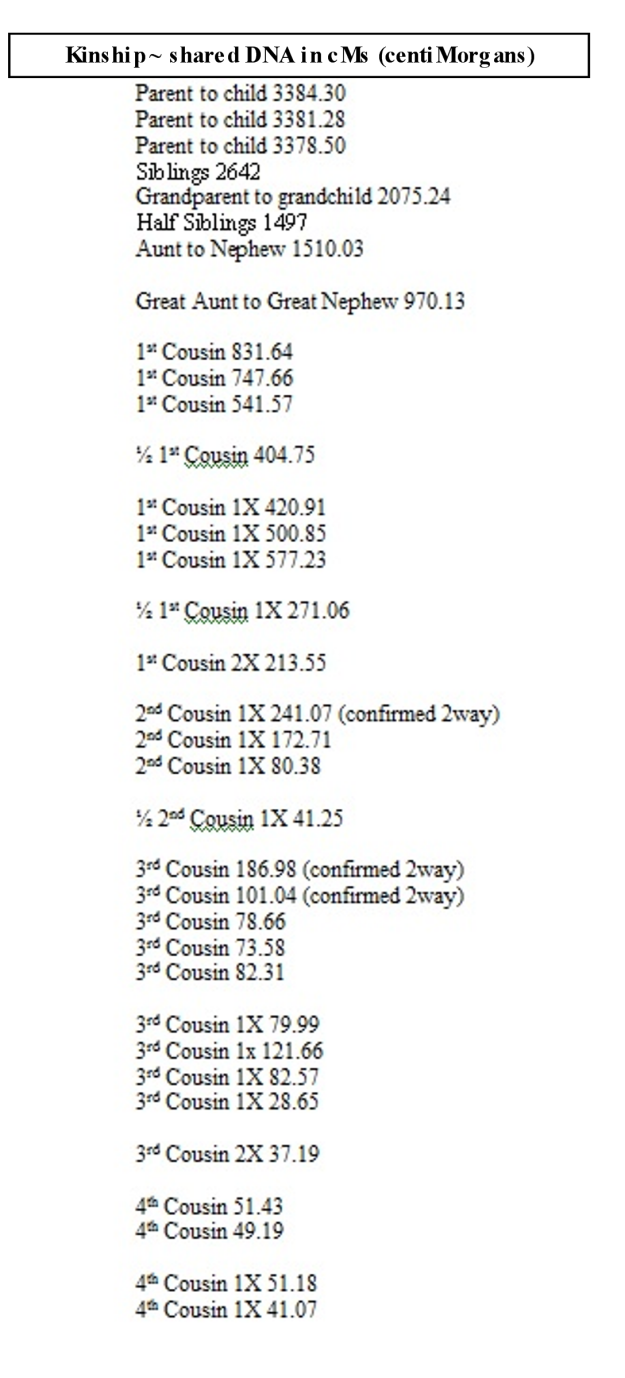We are all excited to match up with our genetic cousins at the several DNA-for-genealogy-and-other-stuff companies. There are many different features at each company, but few that explain the rules of the road or help us to understand the street signs.
We get exactly half of our DNA from each of our parents, but beyond that it is hit and miss as to how much readable DNA we get from any particular ancestor. There is no formula or rule, but there are a few hints to help us understand what we see when we look at our DNA matches.
A lot of our DNA is still not examined in any test, so we cannot believe any result is the end-all. This is important to remember whether looking at matches in autosomal or y-DNA or mt-DNA. It is also important for understanding things like admixture/origins/ethnicity. We must leave room in our minds for our results and what they might mean to change and grow as more is learned.
In autosomal DNA — the main test that all the major companies do — the data so far will definitely show a match between any two people who are 2nd cousins or closer. But 3rd cousins just might not match, and the likelihood of not matching increases with each generation going back. Rarely will autosomal DNA give you lots of usable genealogical information on many distant cousins. To really see how distant cousins are related you need to find multiple people who match each other and then start searching their trees for a common ancestor.
If two siblings compare their DNA to other relatives, they will find that one sibling got more DNA from one grandparent, and the other got more DNA from a different grandparent. So there is some benefit to testing siblings; if one sibling did not match a third person, maybe the other will. (Especially if you want to phase the data – (see another blog 🙂 ) you will really need three siblings.)

This chart is NOT 😦 NOT scientific, but it does not need to be; it illustrates a concept. I have the yellow/orange dots representing, loosely, DNA that is inherited. If you can, imagine that these dots are scrambled to different locations in the DNA of each sibling.
The people, the ancestors here on the chart, are all your biological ancestors but only the ones with yellow dots are your “genetic ancestors.”
The chart shows the grandparents’ generation and says that each grandparent is 25% of us. Physically that is true because there are 4 grandparents. But we might get 10% of our DNA from one of them and 40% from another, 33% from the third grandparent and 17% from the fourth. This will go on at random through the generations of your genetic ancestors.
So if you think, based on paper, that Joe Doe is your 5th cousin and you both test and you do not show a DNA match, you cannot say for certain that you are not related. Many, many of your 5th cousins WILL appear as matches, but some will not. This is where you can improve your chances of figuring out a relationship by having multiple near relatives test and compare results.
We cannot overreach in our guessing how a match might be related. Do not look for the farthest generation to identify a match’s ancestors in common with you. Look at the amount of shared centiMorgans, cMs. Use charts that show you the range that a relationship could be. There are many years of data now and wonderful studies like the shared cMs project (links below). Blaine T. Bettinger has compiled the data and made his work available for all through public pages, groups and websites. Now we can be much more confident in judging how any match might be related. They will either be a, b, or c. Or, a match might be x only or y only. But knowing the probabilities is vital and there are many charts.

A few examples of amounts of shared cMs between people with known relationships. There are more ranges. Just use my favorite GOOGLE 🙂 and the best one that will come up is Blaine Bettinger’s project.
I love having my own cousins test to learn about my DNA. With every generation away from the common ancestor, the DNA becomes more diluted and harder to read. I have my mother and my father’s sister; I have a couple of first cousins and many 2nd and 3rd cousins who have tested. But I had to ask these people to participate. I have wanted to verify that the ancestral families are who they say they are on paper, and although autosomal is limited in its scope, we can keep adding family for testing and verifying relationships. Over time we can verify more and more of our genealogies using not only autosomal DNA but also adding y-DNA and even mt-DNA (mt-DNA has little to offer for genealogy as a rule).
I have written about the value of having your raw DNA data at multiple sites so that you can compare your DNA with more people and organize the results with different tools. For instance when I compare my matches with my mother’s results, I can learn which of my matches come from my mother’s side. And the same for my father’s sister, but this does miss a few things also.
Most of the companies have matches-in-common features, and so with a 2nd cousin from each of my grandparent families – hopefully one cousin from each of 8 or even 16 lines – you can document your entire family tree with DNA.

Each of these y-DNA and mt-DNA haplogroups has come from a test of one of my genetic cousins. Each one is related to me on paper and is related genetically, sharing the correct amount of cMs in autosomal DNA testing, for our presumed relationship. And then that genetic cousin has taken additional, either y-DNA or mt-DNA tests or both, and we not only have their haplogroup which gives that family’s line’s ancient, anthropological ancestry but if they have joined surname and family projects then their DNA might have matched others and so proving family groups, from all around the world.
We might miss carrying readable genes from all of the ancestors in the more distant generations, but person by person, as a genetic family, we can get genetic glimpses of all our ancestors.
We cannot just look at our matches and think – oh this person must match me through X granny because I don’t have many matches from that gran. Maybe you will not have any matches in common through a particular ancestor, but another cousin will.
We should also be prepared to look for the cases where a person might not have been the biological child of who they were thought to be. This happens more often than people realize. This is why I wanted to verify family lines and not just my own DNA. And to do that I needed the added people because I can’t “see” all my own ancestors. I needed a little help from my friends and relatives.
Surname Projects Missed The Point Of “Not” Matching ~ “1 in 10 is mistaken about father’s identity”
DNA Uploads ~ Autosomal Transfers – Autosomal Additions!
https://cherielynnsherstory.com/2019/09/03/dna-uploads-autosomal-transfers-autosomal-additions/
The Shared cM Project

Pingback: Genetic Ancestries, What A Can Of Worms ~ The Three Great Races, oops, great languages, oops, great haplogroups | Cherie Lynn's Herstory